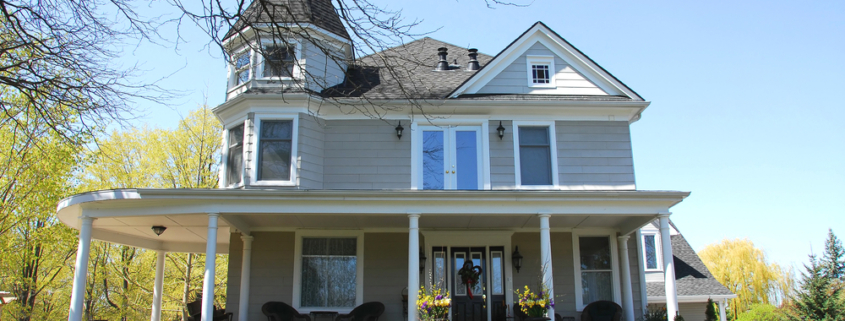Victorian Style House
For more than two hundred years, Victorian houses have been a staple in countless neighborhoods thanks to their whimsical yet grand appearance. For those thinking about purchasing a Victorian home, it’s essential to know what sets a Victorian style house apart.
Click here to learn about other House Styles.
The History of the Victorian Style
Victorian style homes first emerged during the reign of Queen Victoria in the mid-1800s. They were a popular choice well into the early 1900s, and can still be found in areas around the world today. Thanks to the impressive span of Victoria’s empire, this architectural style quickly spread to regions as far-reaching as North America and Australia.
Victorian architecture first evolved from Medieval Gothic and Romanesque styles. It placed new interpretations on old concepts, creating a uniquely eclectic look that, to this day, characterizes Victorian design.
One of the main driving factors in the booming popularity of Victorian homes during the mid to late 1800s was the emergence of brand new building techniques that made construction quicker, easier, and more affordable. Technologies such as factory milling made it possible to create intricate trim work that would take years of effort to complete by hand in just minutes.
Paint technology was also improving rapidly at that point in time. Historically, paint was reserved for only the wealthiest of homes. It was expensive, especially paints in lavish colors, and degraded quickly. However, new long-lasting and weatherproof paints, along with new dyes and colors, made it possible for homes to feature the bright and bold color combinations typical of Victorian architecture.
The mid-1800s was also a time of rapid technological growth in the transportation sector. As railways began to open up states and countries, it became easier and cheaper to transport high-quality construction materials long distances. More homes were able to include luxury siding, trims, and other features that were previously inaccessible.

Why Choose a Victorian Style House?
Victorian style homes are designed to be both fashionable and functional. While features such as windows are considered decorative, they also work to let in light and help to improve air circulation throughout the house. Many have double-hung windows for easy opening and closing.
Thanks to their size, Victorian homes usually offer ample space for plenty of occupants. For the most part, designs include multiple stores. While most feature at least two stories, some include a third with an extra bedroom or attic space.
Their irregular floor plans can offer enough room for even a large family. Cozy nooks and crannies are typical in many Victorian designs, allowing for more storage space or unique play areas for children.
Victorian vs. Edwardian Style Homes
Edwardian style homes came into fashion during the reign of King Edward VII in the early 1900s. While they take their inspiration from the late Victorian homes of the time, Edwardian architecture embraced a more bare-bones appearance.
In general, Edwardian buildings are smaller and include fewer decorative features such as paneling and milled trim. They also tend to have shallower roofs and are designed to be shorter than the traditional Victorian style house. Because of their smaller size and more austere appearance, Edwardian homes can be cheaper and more readily available than Victorian houses.
The Different Styles of Victorian Homes
No two Victorian style homes are quite alike. Though they all share a similar aesthetic, Victorian houses can vary significantly in design and decor. Differences in appearance are primarily regional, though there are plenty of notable exceptions.
Gothic Revival Style
These were some of the first Victorian style houses, inspired by the awe-inspiring architecture of medieval churches throughout Europe. Gothic revival homes often look somewhat like a castle or fortress. Perhaps the most notable design features are the high arches and wood-trimmed gables gracing the facade of the house.
Italianate Style
As the name suggests, this style of Victorian home was inspired by the looks of classic Italian villas. They’re often smaller than other Victorian houses, with a low roof and wide eaves, but Italianate homes are just as ornate as any other Victorian architecture.
Second Empire Style
Second Empire style homes were inspired by contemporary French architecture. They were often more simple in design than other Victorian homes, sticking to a symmetrical rectangular or square foundation. Intricately milled wood decorated the home’s facade to give it charm and character.
Stick-Eastlake Style
Unlike other Victorian style houses, which rely on materials such as brick and stone for construction, Stick-Eastlake homes are mostly constructed of wood. They also typically boast a steep, shingled roof.
Folk Victorian Style
Folk Victorians are designed to be just a little bit smaller and more affordable than the typical Victorian style house. These homes usually have a relatively simple design, with a square, symmetrical base and a basic floor plan. However, they still boast the same ornate decor as actual Victorian homes.
Queen Anne Style
This style of home didn’t appear until the late 1800s, but it’s perhaps one of the most well-recognized Victorian style houses today. These homes feature many typical Victorian features, including gabled roofs, spires and towers, and plenty of ornate trim.

Identifying a Victorian Style House
Victorian homes are known for their large and impressive designs. However, their dollhouse-like appearance also adds a touch of whimsy. Victorian style houses place a heavy influence on decor, with decorative panels, carved trim, oversized arches, and more. Sometimes, the detail on a Victorian style house can seem almost superfluous.
In Victorian design, there’s a heavy emphasis on patterns and shapes. While the decor may seem ornate, it can often be broken down into more basic, repeating elements. Even key features such as roofs and windows are designed to fit the patterning of the house.
Many Victorian homes mix media when it comes to construction. It’s rare to find a Victorian style house that’s made primarily from brick or wood. Instead, the design focuses on including many different textures to create an overarching aesthetic.
House designs are also often asymmetrical, as opposed to many earlier or later architectural styles. Outside, a Victorian style house will often feature seemingly randomly placed towers and turrets along with wide, open porches. The floorplan can be equally unpredictable, with oddly sized rooms and a variation between open and closed design. Walls with uneven or irregular shapes are also common.
One of the most prominent features of any Victorian home, both inside and out, is the windows. They tend to vary wildly in their design, frequently changing between floors or different areas of the house. There are several popular window styles used in Victorian architecture, including:
- Bay windows to add light and space to main rooms
- Eyebrow windows to break up the roof and light upper spaces
- Double pane windows for airflow
- Elliptical cameo windows to accentuate the entryway or foyer
- Stained glass windows for color
- Side-by-side window strips
- Casement windows for a medieval feel
- Elizabethan windows to add a Tudor touch
- Gothic pointed arch gable windows
- Grand oriels framed in wood, stone, or other housing material
- Bowed windows for curved towers and turrets
Victorian homes are whimsical and unique, emphasizing detailed decor and unpredictable design schemes. From Gothic Revival homes to Queen Anne style houses, it’s easy to see why the Victorian style house remains popular to this day.



